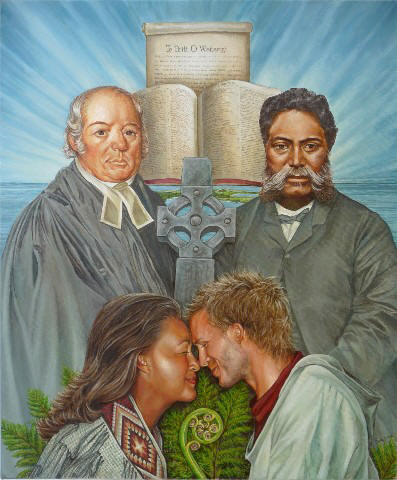|
Ngapuhi’s
history shaping drama |
|
An opinion piece. August 2010: The claim Ngapuhi did not ‘cede sovereignty’ when they signed the Treaty of Waitangi, appears to be cunning stagecraft, designed to provoke debate on the nation-shaping events of the past 200-years. The opening scenes of this rich treaty settlement drama, played out in
May in a large white tent pitched at Ti Tii Marae where the Treaty of
Waitangi was signed in 1840, threw out a wero or challenge to the nation.
Despite wildly differing tribal views, this was a rallying cry as Ngapuhi laid out an agenda to reframe the events of the past; and based on the potential settlement of 1200 claims, set their economic sights on new horizons. As Erima Henare, a former senior Government executive with strong ties to the north, told the Weekend Herald (15 May 2010), his relatives don’t want a dry recitation of history from the Waitangi Tribunal hearing, they want a show. And perhaps it is not unreasonable to expect one. The events of 5-6 February 1840 were full of drama; British pomp and ceremony, religious rivalry between the Protestant missionaries and the Catholic Bishop Pompallier, and a challenging and emotional display of Maori oratory and drama. In the wider context though a much larger drama was playing out on the world stage, with New Zealand as a test case; which it still is in many ways, for improved race relations. Humanitarian activists William Wilberforce, Charles Grant (Lord Glenelg), James Stephen and their successors in the so-called Clapham Sect; who’s Christian-based reforms bought an end to slavery, were determined this would be the first nation where Britain signed a partnership treaty with the indigenous people. Clear assurances given
It had taken the missionaries 20-years from 1814 to win the trust of
Maori, learn their language and customs and displace the propensity for
merciless utu or ‘an eye for an eye’ with the principles of forgiveness and
‘love thy neighbour’. Semantics aside, the Treaty of Waitangi could never have been signed without this socio-spiritual shift, nor could it have come into being without the specific consent, participation and indeed urging of Ngapuhi. Hone Heke, the bold Ngapuhi chief and astute businessman who was in fact an Anglican layreader, believed he and his people would benefit significantly from signing. When Hobson asked for signatures on 6 February 1840, it was Heke who first stepped forward and convinced his peers. Within three years however the last of the humanitarian Christians in the Colonial Office had been ousted from power, and a new British administration dismissed ‘the treaty of tears’ as ‘injudicious’. It recommended the Crown take ownership of all unoccupied Maori land and funded the New Zealand Company to 'extinguish’ any remaining M āori title on land it had been granted.Heke, Henry Williams and the other missionaries, felt a keen sense of betrayal. Heke, who once demanded landing fees from visiting ships, was now being charged to land his own waka at Kororareka. The much prided flag of the United Tribes was gone and flying on the pole hewn from Heke’s own forest was the Union Jack. Acts one to four of the flagpole felling drama were designed to gain the attention of the new governor FitzRoy to explain why the flags couldn’t fly together, why Maori mana had been undermined and all the promises were turning to dust? Fading to Grey From 1860 as land wars escalated across central North Island, Ngapuhi in the far north — still under the strong influence of Christianity and loyal to the Crown — remained in relative peace. Now the country’s largest iwi raise a constitutional conundrum, in much
the same manner as their activist ancestor Hone Heke raised an axe to the
flagpole. Ngapuhi suggest they are independent and not party to the English
version of the treaty. So what is the baseline for
settlement and who is liable for the claims to
most everything north of Auckland city? It is said the implications could "rock the nation constitutionally". However New Zealand’s ‘constitution’ is already a shambolic thing, comprising various pieces of legislation, legal documents, common law court decisions, established practices and conventions and awkward references to variously interpreted treaty principals. Obviously though the Maori version of the treaty remains central to the
debate, and Ngapuhi are right to ask where is the Anglican Church in all of
this? After all this was an agreement signed in faith because Maori trusted
the missionaries. Perhaps this living history lesson could serve as a catalyst to complete the nation building exercise that began not in 1840 but in 1814 when the foundational relationships between two peoples were first forged. Dare we ask whether this young Pacific nation at the sunrise edge of the
world is ready to pass from post-colonial pubescence with a visionary
constitution that embraces the true spirit of the treaty? Keith Newman is a freelance writer and published author. His latest book
Bible & Treaty: Missionaries and Maori – a new perspective (Penguin)
is now as they say, available in all good book shops and libraries |
